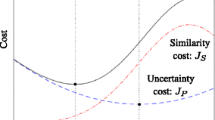Abstract
Tracking multiple targets is a challenging problem, especially when the targets are “identical”, in the sense that the same model is used to describe each target. In this case, simply instantiating several independent 1-body trackers is not an adequate solution, because the independent trackers tend to coalesce onto the best-fitting target. This paper presents an observation density for tracking which solves this problem by exhibiting a probabilistic exclusion principle. Exclusion arises naturally from a systematic derivation of the observation density, without relying on heuristics. Another important contribution of the paper is the presentation of partitioned sampling, a new sampling method for multiple object tracking. Partitioned sampling avoids the high computational load associated with fully coupled trackers, while retaining the desirable properties of coupling.
Similar content being viewed by others
References
Bar-Shalom, Y. and Fortmann, T. 1988. Tracking and Data Association. Academic Press.
Baumberg, A. and Hogg, D. 1994. Learning flexible models from image sequences. In Proc. 3rd European Conf. Computer Vision, Eklundh, J.-O. (Eds.). Springer-Verlag, pp. 299–308.
Billingsley, P. 1995. Probability and Measure. 3rd edition, Wiley.
Blake, A. and Isard, M. 1998. Active Contours. Springer.
Carpenter, J., Clifford, P., and Fearnhead, P. 1999. An improved particle filter for non-linear problems. IEE Proceedings–Radar, Sonar and Navigation, 146:2–7.
Chellappa, R. and Jain, A. 1993. Markov Random Fields: Theory and Application. Academic Press.
Cootes, T. and Taylor, C. 1992. Active shape models. In Proc. British Machine Vision Conf., pp. 265–275.
Del Moral, P. 1998. Measure-valued processes and interacting particle systems: application to nonlinear filtering problems. The Annals of Applied Probability, 8(2):438–495.
Doucet, A. 1998. On sequential simulation-based methods for Bayesian filtering. Technical Report CUED/F-INFENG/TR310, Dept. of Engineering, University of Cambridge.
Gordon, N. 1997. A hybrid bootstrap filter for target tracking in clutter. IEEE Trans. Aero. Elec. Systems, 33:353–358.
Haritaoglu, I., Harwood, D., and Davis, L. 1998. w 4 s: A real-time system for detecting and tracking people in 2.5D. In Proc. 5th European Conf. Computer Vision, Freiburg, Germany. Springer Verlag, Vol. 1, pp. 877–892.
Hinton, G., Williams, C., and Revow, M. 1992. Adaptive elastic models for hand-printed character recognition. Advances in Neural Information Processing Systems, 4.
Intille, S., Davis, J., and Bobick, A. 1997. Real-time closed-world tracking. In Proc. Conf. Computer Vision and Pattern Recognition, pp. 697–703.
Irani, M. and Anandan, P. 1998. A unified approach to moving object detection in 2D and 3D scenes. IEEE Trans. on Pattern Analysis and Machine Intelligence, 20(6).
Isard, M. and Blake, A. 1998a. Condensation–conditional density propagation for visual tracking. Int. J. Computer Vision, 28(1):5–28.
Isard, M. and Blake, A. 1998b. Icondensation: Unifying low-level and high-level tracking in a stochastic framework. In Proc. 5th European Conf. Computer Vision, pp. 893–908.
Isard, M. and Blake, A. 1998c. A mixed-state Condensation tracker with automatic model switching. In Proc. 6th Int. Conf. on Computer Vision, pp. 107–112.
Kass, M., Witkin, A., and Terzopoulos, D. 1987. Snakes: Active contour models. In Proc. 1st Int. Conf. on Computer Vision, pp. 259–268.
Kent, J., Mardia, K., and Walder, A. 1996. Conditional cyclic markov random fields. Adv. Appl. Prob. (SGSA), 28:1–12.
Koller, D., Weber, J., and Malik, J. 1994. Robust multiple car tracking with occlusion reasoning. In Proc. 3rd European Conf. Computer Vision, Springer-Verlag, pp. 189–196.
Kong, A., Liu, S., and Wong, W. 1994. Sequential imputations and Bayesian missing data problems. J. Am. Stat. Assoc., 89(425):278–288.
Liu, J. and Chen, R. 1995. Blind deconvolution via sequential imputations. J. Am. Stat. Assoc., 90(430):567–576.
Liu, J. and Chen, R. 1998. Sequential monte carlo methods for dynamic systems. J. Amer. Statist. Assoc., 93:1032–1044.
Lowe, D. 1992. Robust model-based motion tracking through the integration of search and estimation. Int. J. Computer Vision, 8(2):113–122.
MacCormick, J. 2000. Probabilistic models and stochastic algorithms for visual tracking. Ph.D. Thesis, University of Oxford.
MacCormick, J. and Blake, A. 1998a. A probabilistic contour discriminant for object localisation. In Proc. 6th Int. Conf. on Computer Vision, pp. 390–395.
MacCormick, J. and Blake, A. 1998b. Spatial dependence in the observation of visual contours. In Proc. 5th European Conf. Computer Vision, pp. 765–781.
Mumford, D. and Gidas, B. 1999. Stochastic models for generic images. Technical report, Divison of Applied Mathematics, Brown University.
Mumford, D. and Nitzberg, M. 1990. The 2.1d sketch. In Proc. 3rd Int. Conf. on Computer Vision, pp. 138–144.
Paragios, N. and Deriche, R. 1998. A PDE-based level-set approach for detection and tracking of moving objects. In Proc. 6th International Conf. Computer Vision, pp. 1139–1145.
Peterfreund, N. 1998. Robust tracking with spatio-velocity snakes: Kalman filtering approach. In Proc. 6th International Conf. Computer Vision, pp. 433–439.
Pitt, M. and Shepherd, N. 1997. Filtering via simulation and auxiliary particle filters. Technical report, Nuffield College, University of Oxford.
Rasmussen, C. and Hager, G. 1998. Joint probabilistic techniques for tracking multi-part objects. In Proc. Conf. Computer Vision and Pattern Recognition, pp. 16–21.
Szeliski, R. and Terzopoulos, D. 1991. Physically-based and probabilistic models for computer vision. In SPIE Procs. Geometric methods in computer vision, Vol. 1570, Vemuri, B. (Ed.).
Winkler, G. 1995. Image Analysis, Random Fields and Dynamic Monte Carlo Methods. Springer.
Zhu, S., Wu, Y., and Mumford, D. 1998. Filters, random fields and maximum entropy (FRAME). Int. J. Computer Vision, 27(2):107–126.
Author information
Authors and Affiliations
Rights and permissions
About this article
Cite this article
MacCormick, J., Blake, A. A Probabilistic Exclusion Principle for Tracking Multiple Objects. International Journal of Computer Vision 39, 57–71 (2000). https://doi.org/10.1023/A:1008122218374
Issue Date:
DOI: https://doi.org/10.1023/A:1008122218374




